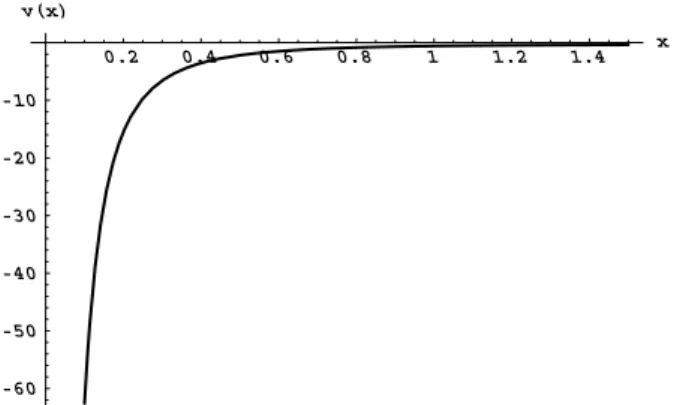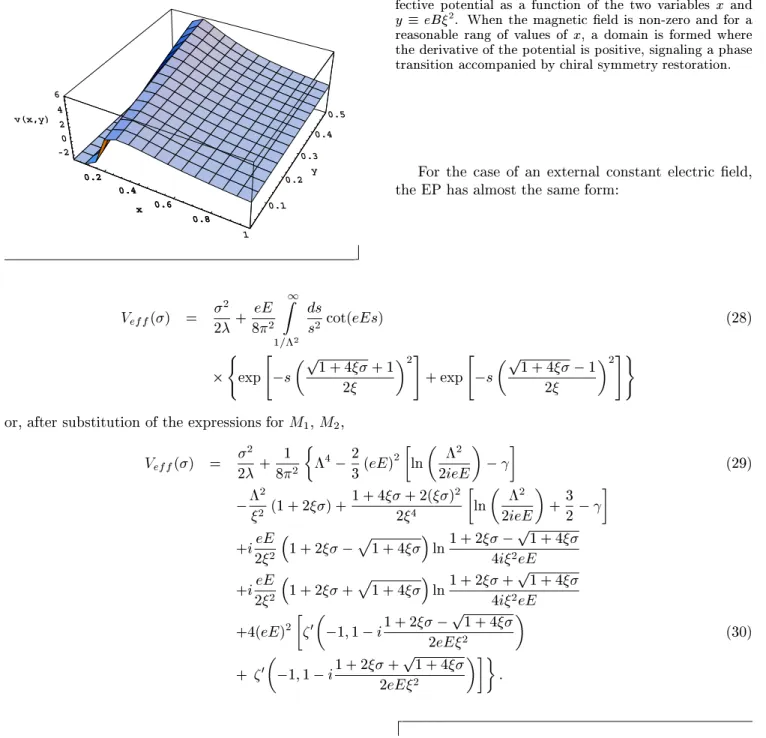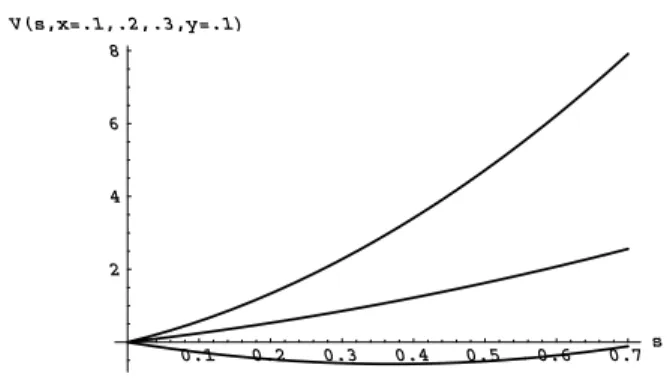Dynamial Symmetry Restoration for a
Higher-Derivative Four-Fermion Model
in an External Eletromagneti Field
E. Elizalde 1;2;
, S.P.Gavrilov 3;4;y
, S.D. Odintsov 1;4;z
, and Yu. I. Shil'nov 1;5;x
1
ConsejoSuperior deInvestigaionesCientas,
IEEC,EdiiNexus-204,GranCapita2-4,08034, Barelona,Spain
2
Department ECM,Faulty of Physis,University of Barelona,
Diagonal 647,08028,Barelona,Spain
3
Departamento de Fsia, CCET, UniversidadeFederal de Sergipe,
490000-000 Araaju,SE, Brasil
4
Department of Mathematis and Physis,
Tomsk PedagogialUniversity,634041, Tomsk,Russia
5
Department of Theoretial Physis, Faulty of Physis,
Kharkov StateUniversity,SvobodySq. 4,310077,Kharkov, Ukraine
Reeived31Marh,2000
Afour-fermionmodelwithadditionalhigher-derivativetermsisinvestigatedinanexternal
eletro-magnetield. The eetive potentialinthe leading orderof large-N expansionisalulated in
externalonstant magnetiandeletri elds. Itis shownthat, inontrast tothe formerresults
onerning the universal harater of \magneti atalysis" in dynamial symmetry breaking, in
thepresenthigher-derivativemodelthemagnetieldrestoreshiralsymmetrybrokeninitiallyon
thetree level. Numerialresults desribingaseond-orderphasetransition thataompanies the
symmetryrestorationatthequantumlevelarepresented.
I Introdution
Thedynamialsymmetrybreaking(DSB)issuehas
at-trated a lot of attention sinethe appearene of the
seminal paper by Nambu and Jona-Lasinio [1℄. It is,
in fat, the most eonomialway to realize theHiggs
mehanism. Ithasbeenappliedtothestudyofdierent
models ofmodern quantum eld theory[3℄, espeially
four-fermion ones [1,2℄, where it is viewed as a
low-energyeetiveationofstronginterationsphysis[4℄.
Chiral symmetry (CS) breaking and dynamial
fermion mass generation in four-fermion models have
beeninvestigatedinthepreseneofexternalelds:
ele-tromagneti [5℄-[11℄,gravitational[12℄- [14℄,and their
ombination[14℄, [15℄. Ithasbeenobservedthatboth
apositivespaetimeurvatureandanexternaleletri
eld try to restore hiral symmetry while a magneti
eldandnegativeurvaturealwaysbreakit. Therefore
external elds have been shown to indue some new
phasetransitionsand enrih themodel phasediagram
essentially.
Higher-derivativeextensionsoftheNJLmodelhave
been disussed reently owing to dierent reasons.
First,amodelwithhigher-derivativetermsinthe
inter-ationvertexwasproposed that exhibits anintersting
equivalene with the symplied theory of eletroweak
interations[16℄. These terms ofthe low-energy
ee-tiveationwereshowntobeessentialandeven
unavoid-able in the strong oupling regime, where a
nontriv-ialphase diagram with apoliritial point wasshown
to exist [17℄. On the other hand, someregularization
shemesbasedontheintrodutionofadditional
higher-derivative terms into the initial kineti one were
dis-ussed[18℄. Furthemore,gravityeets upon theDSB
for the former variant of high-derivative NJL model
wereinvestigatedaswell[19℄.
InthepresentpaperwestudytheDSBinthe
four-fermionmodelwithahigher-derivativekinetiterm[18℄
E-mail:elizeta.em.ub.es,elizaldeio.iee.fr.es
y
E-mail:gavrilovufs.br
z
E-mail:odintsovtspi.tomsk.su
in anexternaleletromagnetield. Itisofinterestto
hekup if the \universal rules"onerning magneti
atalysisof DSB and hiral symmetry restoration
un-der the inuene of eletri elds work for this more
ompliatedmodel.
II Eetive potential of the
higher-derivative model
We are going to investigate ahigher-derivative
gener-alizationoftheNJL-likemodelinanexternalonstant
eletromagnetield withthefollowingation:
S= Z
d 4
x
h
iD
+(
iD
)
2 i
+
2N
( ) 2
+( i
5 )
2
; (1)
wheretheovariantderivativeD
inludes theeletromagnetipotentialA
:
D
=
ieA
: (2)
Itshould benotedthat inourmodel CSisalreadybrokenonthetreelevelwhen 6=0in ontrasttotheoriginal
NJLase. Byintroduingtheauxiliaryelds
=
N
( ); =
N i
5
; (3)
weanrewritetheationas
S = Z
d 4
x
h
iD
+(
iD
)
2
(+i
5 )
i
N
2 (
2
+ 2
)
: (4)
Then,theeetiveationin thelarge-N expansionisgivenby
1
N eff
(;)= Z
d 4
x
2
+ 2
2
ilndet n
i
(x)D
+(
iD
)
2
(+i
5 )
o
: (5)
Herewean put=0,beausethenalexpressionwilldependontheombination 2
+ 2
only.
Deningtheeetivepotential(EP)asV
eff =
eff =N
Z
d 4
x,foronstantongurationsof and weget
V
eff =
2
2
+iSpln hxj[
iD
+(
iD
)
2
℄jxi: (6)
BymeansoftheGreenfuntion (GF)whih obeystheequation
(i
D
+(
iD
)
2
)
x G(x;x
0
;)=Æ(x x 0
); (7)
weobtainthefollowingformula
V 0
eff ()=
iSpG(x;x;): (8)
TondouttheGFG(x;x 0
;)itisonvenienttorepresentthehigher-derivativeoperatorin theform
i
D
+(
iD
)
2
=(i
D
M
1 )(i
D
M
2
); (9)
where
M
1 =
1+ p
1+4
2
; M
2 =
1 p
1+4
2
: (10)
d
Here,wesupposethat 1=4. Thenweanrepre- senttheGF as
G(x;x 0
;)=(1+4) 1=2
fS(x;x 0
;M
1
) S(x;x 0
;M
where thefuntions S(x;x 0
;M
i
)obeytheequation:
(i
D
M
i )
x S(x;x
0
;M
i
)=Æ(x x 0
) (12)
and i =1;2. This is exatlythe usual GF of massive
fermions in a onstant external eletromagneti eld,
whoseproper-timerepresentationiswell-known[5℄. We
have now derived all thepreliminary formulaeneeded
to onstruttheEPof ourmodel.
III Dynamial symmetry
break-ing without an external eld
Intheabseneofaneletromagnetield, theGF(12)
intheproper-timerepresentationhastheform[5℄:
S(x x 0
;M
i )=
1
Z
1= 2
ds
(4s) 2
exp
isM
i 2
i
4s (x x
0
) 2
M
i +
1
2s
(x x 0
)
; (13)
d
where isan ultraviolet ut-o parameter. It should
be noted that, in ontrast to the paper [18℄, where
UV divergenes have been dealt with by introduing
a ut-oas amultiplier of the higher-derivativeterm,
wehaveto insertin ourpresentmodel thisspeial
pa-rameter anyway. Thepointis thattheationofour
model ontains only squares of derivativesand this is
not enough in order to regularize one-loop Feynman
graphsinafour-dimensionalspaetime. Meanwhilethe
kinetitermofthemodelstudiedin[18℄ontainsa
u-bi higher-derivative term whih provides a omplete
regularizationofanydiagram.
TheEPgeneratedbythetwofuntionsS(x;x 0
;M
i )
isthefollowing
V
eff
()= 4i(1+4) 1=2
2
4 M1
Z
0
dmSpS(x;x;m) M2
Z
0
dmSpS(x;x;m) 3
5
; (14)
where themultiplier4isthedimensionofthefermionrepresentation,andtheoppositesignoftheseondintegral
should benoted. After aWik rotation, is ! s, and integration overm, we get apositive expressions forboth
termsofEP(14)andnonegativemodesappearhere. ThereforetheEPanbewritten as
V
eff ()=
2
2 +
1
8 2
1
Z
1= 2
ds
s 3
e sM
2
1
+e sM
2
2
: (15)
Substitutingheretheexpressions(10)andperfomingtheintegrationovers,wenallyobtaintheeetivepotential
(6)
V
eff () =
2
2 +
1
16 2
4
2 4
4
2 2
2
(1+2)+( 3
2 )
h
1+4+2() 2
i
1
2 h
1+4+2() 2
(1+2) p
1+4 i
ln
1+2 p
1+4
2 2
2
(16)
1
2 h
1+4+2() 2
+(1+2) p
1+4 i
ln
1+2+ p
1+4
2 2
2
whereweassumethat <<.
Thegapequation
V 0
eff
()=0 (17)
anbefounddiretlyandCSturnsouttobebrokenfor
anyvalueoftheouplingonstantand>0,beause
V 0
eff (0)=
1
4 2
3
2
2
+1 +ln 2
2
(18)
is always negative (see Fig. 1). This is an absolutely
naturalresultbeausethehigher-derivativeterminthe
ation(1)isnoninvariantunderhiraltransformations,
bothofontinuousanddisretetype. Itausesthe
pres-eneof abare urrentmasswhih ispreservedevenin
thelimit!0whenM 2
2 !1=
2
beingnon-zeroin all
ases.
0.2
0.4
0.6
0.8
1
1.2
1.4
x
-60
-50
-40
-30
-20
-10
v(x)
Figure 1. Plot ofthe derivativev V 0
eff (0)=
3
of the
ef-fetivepotentialfor=0versusthedimensionlessvariable
x
2
2
. Thefatthat thisderivativeis alwaysnegative
provesthathiralsymmetryisalwaysbrokenaswell.
IV Symmetry restoration
un-der the inuene of external
onstant magneti or
ele-tri elds
TheGFinanexternalonstantmagnetield isgiven
by[5,10℄:
S(x x 0
;M
i )=
1
Z
1= 2
ds
(4s) 2
e isMi
2
exp( i
4s (x x
0
)
C
(x x 0
)
) (19)
M
i +
1
2s
C
(x x
0
)
e
2
F
(x x
0
)
eBsot(eBs) es
2
F
;
where
C
=
+F
F
1 eBsot(eBs)
B 2
: (20)
Then,weanwritetheEP
V
eff ()=
2
2 +
eB
8 2
1
Z
1= 2
ds
s 2
oth(eBs) (21)
(
exp "
s p
1+4+1
2
2 #
+exp "
s p
1+4 1
2
2 #)
Themostreliablemethodto dealwiththedivergenesis theut-o sheme. We anmakethefollowingtrik: to
writetheintegralin theEPintheform
1
Z
2 ds
s 3
e sM
2
i
(eBs)oth(eBs) 1 1
3 (eBs)
2
+ 1
Z
2 ds
s 3
e sM
2
i
1+ 1
3 (eBs)
2
andtoalulatethelastonebykeepingnite,whiletherstintegralisnitealready,sothatweanset1= 2
=0
at thelowerlimit. Thenitappearsto bepossibletoalulate itlikealimit! 1,byusing theformula
1 Z 0 dxx 1 e ax
oth(x)= () h 2 1 () (; a 2 ) a i : (23)
After integrationovers,weget
V eff () = 2 2 + 1 8 2 4 + 2 3 (eB) 2 ln 2 2eB (24) M 2 1 +M 2 2 2 + 1 2 M 4 1 +M 4 2 ln 2 2eB +1 +eB M 2 1 ln M 2 1 2eB +M 2 2 ln (M 2 2 2eB 4(eB) 2 0 1; M 2 1 2eB +1 + 0 1; M 2 2 2eB +1 +O 1 ; where 0
( ;x)= d
d
( ;x): (25)
Substituting theexpressionsforM 2
1
andM 2
2
,weobtainthefollowingformulafortheEP
V eff () = 2 2 + 1 8 2 4 + 2 3 ( eB) 2 ln 2 2eB (26) 2 2
( 1+2)+
1+4+2() 2 2 4 ln 2 2eB + 3 2 + eB 2 2
1+2 p
1+4
ln
1+2 p
1+4
4 2 eB + eB 2 2
1+2+ p
1+4
ln
1+2+ p
1+4
4 2 eB 4(eB) 2 0
1;1+
1+2 p
1+4
2eB 2 + 0
1;1+
1+2+ p
1+4
2eB 2
Tosee ifthere areanypossibilitiesfor restorationof thehiral symmetryin this model, one should alulate the
derivativeV 0
eff
()attheorigin=0:
V 0 eff (0)= 1 8 2 3 2ln( 2 2 ) 2 2 2
+3 2+2eB 2 2ln(2eB 2 ) (27) 2eB 2 ln(2eB 2
)+2eB 2 ln(2) 4eB 2 ln 1+ 1 2eB 2 d
Itshouldbenotedthatthisformuladoesnotreprodue
Eq. (18)in the limitB !0, due to theirumstane
that it wasatually alulated asthe zero-order term
inthepowerexpansiononthedimensionlessparameter
2
=eB. Thus,one hastokeepeB nitehere.
As is lear from Fig. 2, there is a rather big area
of values of the magneti eld strength and the
ut-o parameter where the derivativeV 0
(0) is positive.
ThatindiatestheCSrestorationonthequantumlevel.
The orresponding numerial analysis proves in fat
that this rerstoration ours ontinuously with
mag-netield strengthgrowth. Thismeansthatthereisa
seond-orderphasetransition asshown in Fig.3. The
sametype of phasetransition indued by ahange of
0.2
0.4
0.6
0.8
1
x
0.1
0.2
0.3
0.4
0.5
y
-2
0
2
4
6
v(x,y)
0.2
0.4
0.6
0.8
x
Figure2. Plotofthederivativevalue V 0
eff (0)=
3
ofthe
ef-fetive potential as a funtion of the two variables x and
y eB 2
. Whenthe magnetield is non-zero and fora
reasonable rang of values of x, a domainis formed where
thederivativeofthepotentialispositive,signalingaphase
transitionaompaniedbyhiralsymmetryrestoration.
For the ase of an external onstant eletri eld,
theEPhasalmostthesameform:
V
eff () =
2
2 +
eE
8 2
1
Z
1= 2
ds
s 2
ot(eEs) (28)
(
exp "
s p
1+4+1
2
2 #
+exp "
s p
1+4 1
2
2 # )
or,aftersubstitutionoftheexpressionsforM
1 ;M
2 ,
V
eff () =
2
2 +
1
8 2
4
2
3 (eE)
2
ln
2
2ieE
(29)
2
2
(1+2)+
1+4+2() 2
2 4
ln
2
2ieE
+ 3
2
+i eE
2 2
1+2 p
1+4
ln
1+2 p
1+4
4i 2
eE
+i eE
2 2
1+2+ p
1+4
ln
1+2+ p
1+4
4i 2
eE
+4(eE) 2
0
1;1 i 1+2
p
1+4
2eE 2
(30)
+ 0
1;1 i
1+2+ p
1+4
2eE 2
:
d
Thisexpressionhasanimaginarypartdeninga
parti-le reationveloity, andstritlyspeakingthevauum
beomesunstable[20℄. However,forsomesmallvalues
of the eletrield strength, when partile reationis
still exponentiallydepressed,wean performan
anal-ysisoftheDSB phenomenonusingtherealpartofthe
EP.
Toestimate ifsymmetry restorationtakesplae in
anexternaleletrield, weanuseagainthevalueof
thederivativeoftheEPattheorigin:
ReV 0
eff (0) =
1
8 2
3
2ln( 2
2
) 2
2
2
+3 2 (31)
2ln(2eE 2
)+eE 2
+4eE 2
arg
1 i
Performing now a numerial analysis of the same
fashionasinprevioussetion,wemaygetqualitatively
thesameresults.ThereareregionswhereCSisrestored
due to the eletrial eld eet. Being the proedure
verysimilar, wedo notpresenthereexpliit guresof
that analysisforthesakeofonissness.
0.1
0.2
0.3
0.4
0.5
0.6
0.7
s
2
4
6
8
V(s,x=.1,.2,.3,y=.1)
Figure3. Plot oftheeetivepotentialV(s)[Veff()
Veff(0)℄= 4
asafuntionofs=,forapartiularvalue
ofx=:15andthreedierentvaluesofy=:05;:15;:3,
show-ingthatthephasetransitiontakesplae.
0.05
0.1
0.15
0.2
s
-1
1
2
3
4
5
V(s,x=.15,y=.05,.15,.3)
Figure4. PlotofthepotentialV(s)butnowforapartiular
valueofy=:1andseveralvaluesofx=:1;:2;:3.
V Conlusions
Wehavestudiedinthispapertheinueneofmagneti
and eletriexternal elds on the CS restoration in a
higher-derivativeNJL-likemodel,wherethissymmetry
is broken already in the absene of external elds. It
hasbeenshownthatadomainofparametervalues
ex-ists within the rangeof validity of our approximation
where the external magneti or eletri elds restore
hiralsymmetry,atleastatthequantumlevel. Thisis
in ontrast to the magneti atalysisphenomenon
o-Fortunatelythephasetransitionaompanyingthis
symmetryrestorationisaseondorderoneandits
on-tinuous haraterreasuresus ontheorretnessofour
approximation. Infat,withinthebrokenphase,for
ev-eryvalueofthereissomeviinityoftheoriginwhere
min
<< ,in aordanewith therestritionsunder
whih we have obtained the formula for the eetive
potential.
It should also be noted that it is not diÆult to
extendourmodel(andouralulationalsheme)to
in-ludeother higherderivativetermsinthekinetipiee
of the Lagrangian. In partiular, one an onsider a
Lagrangianwithatermoffourthorder.
Wewould liketothankA.A.Andrianovforhelpful
disussions. Thisworkhasbeenpartlynanedby
DG-ICYT(Spain),projetPB96-0925,andbyCIRIT
(Gen-eralitat de Catalunya), grant 1995SGR-00602. The
workofYu.I.Sh. wassupportedinpartbyMinisteriode
Eduaiony Cultura(Spain),grantSB96-AN4620572.
The work by S.D.O. has been partially supported by
MEC(Spain). Thework byS.P.G.has been partially
supportedbyFAPESE(Brazil).
Referenes
[1℄ Y. Nambu, G Jona-Lasinio, Phys. Rev. 122, 345
(1961).
[2℄ D.Gross,A.Neveu,Phys.Rev.D10,3235(1974).
[3℄ E. Fahri and R. Jakiw, Eds., Dynamial Symmetry
Breaking(WorldSienti,Singapore,1981);T.Muta
andK.Yamawaki,Eds.,Proeedings of theWorkshop
onDynamialSymmetryBreaking(Nagoya,1990);W.
A.Bardeen,J.KodairaandT.Muta,Eds.,Proeedings
oftheInternationalWorkshoponEletroweak
Symme-tryBreaking(WorldSienti,Singapore,1991)
[4℄ M.Bando,T.Kugo,K.Yamawaki,Phys.Rep.164,217
(1988); B.Rosenstein, B. J.Warr, S.H. Park, Phys.
Rep. 205, 59 (1991);T. Hatsuda, T. Kinuhiro, Phys.
Rep.247,221(1994);J.Bijnens, Phys.Rep.265,369
(1996).
[5℄ J.Shwinger,Phys.Rev.82,664(1951).
[6℄ B.J.Harrington,S.Y.Park,A.Yildiz,Phys.Rev.D11,
1472(1975);M.Stone,Phys.Rev.D14,3568 (1976);
S.Kawati,G.Konisi,H.Miyata,Phys.Rev.D281537
(1983).
[7℄ S.P.Klevansky,R.H.Lemmer,Phys.Rev.D39,3478
(1989);S.Klevansky,Rev.Mod.Phys.64,649(1992).
[8℄ K. G. Klimenko, Theor. Math. Phys., 89, 211, 388
(1991);Z.Phys.C 54, 323(1992); I.Krive and S.
Naf-tulin, Phys.Rev.D46, 2337 (1992); K. Klimenko, A.
S.VshivtsevandB.V.Magnitsky,NuovoCim.A107,
439(1994);JETPLett.61,871(1995).
[10℄ D.Cangemi,G.Dunne,E.D'Hoker,Phys.Rev.D51,
R2513(1995);D52, R3163(1995); V.P.Gusynin,V.
A. Miransky, I.A. Shovkovoy, Nul.Phys. B462, 249
(1996);C.N.Leung,Y.J.NgandA.W.Akly,Phys.
Rev.D54, 4181 (1996);D.-S. Lee, C.N. Leung,Y. J.
Ng,Phys.Rev.D55,6504(1997);
V.A.Miransky,hep-th/9805159.
[11℄ M. Ishi-i, T. Kashiwa and N. Tanemura,
KYUSHU-HET-40, hep-th/9707248; S. Kanemura, H.-T. Sato
andH.Tohimura,Nul.Phys.B517, 567(1998).
[12℄ T.Muta, S. D.Odintsov, Mod.Phys.Lett. A6, 3641
(1991);C.T.HillandD.S.Salopek,Ann.Phys.(NY),
213,21(1992); T.Inagaki, T.Muta, S.D.Odintsov,
Mod. Phys.Lett. A8, 2117 (1993);E. Elizalde, S. D.
Odintsov, Yu. I. Shil'nov, Mod.Phys. Lett. A9, 913
(1994);T.Inagaki,S.MukaigawaandT.Muta,Phys.
Rev.D52,R4267(1996);E.Elizalde,S.Leseduarte, S.
D. Odintsov, Yu. I. Shil'nov, Phys. Rev. D53, 1917
(1996);S.KanemuraandH.-T.Sato,Mod.Phys.Lett.
A24,1777 (1995); G. Miele, P. Vitale, Nul. Phys.,
B494,365(1997);M.A.Vdovihenko,A.S.Vshivtsev
andK.G.Klimenko,JETP,1998,toappear.
[13℄ I. L. Buhbinder, S. D. Odintsov, I. L. Shapiro,
Ef-fetive Ation in Quantum Gravity, (IOPPublishing,
BristolandPhiladelphia,1992.)
[14℄ T.Inagaki, T.MutaS.D.Odintsov,Dynamial
Sym-metry Breaking in Curved Spaetime, Prog. Theor.
Phys.Suppl.127,93(1997).
[15℄ D. M. Gitman,S.D. Odintsov,Yu.I.Shil'nov, Phys.
Rev. D54, 2968 (1996); B. Geyer, L. N. Granda, S.
D. Odintsov, Mod.Phys.Lett. A11, 2053 (1996); E.
Elizalde, S.D.Odintsov, A.Romeo,Phys.Rev.D54,
4152(1996);T.Inagaki,S.D.Odintsov,Yu.I.Shil'nov,
KOBE-TH-97-02, hep-th/9709077;E. Elizalde, Yu. I.
Shil'nov, V. V. Chitov, Class. Quant. Grav. 15, 735
(1998).
[16℄ M. Suzuki, Mod. Phys. Lett. A5, 1205 (1990); A.
Hazenfrantz,K.Jansen,J.Kuti,Y.Shen,Nul.Phys.
B365,79(1991).
[17℄ A. A. Andrianov, V. A.Andrianov, Int. Journ.Mod.
Phys.A8,1981(1993);A.A.Andrianov,V.A.
Andri-anov, V. L. Yudihev, Theor.Math. Phys.108, 1069
(1996).
[18℄ T. Hamazaki, T. Kugo, Progr. Theor. Phys. 92, 645
(1994).
[19℄ E.Elizalde,S.Leseduarte,S.D.Odintsov,Phys.Lett.
B347,33(1995).
[20℄ S.P.GavrilovandD.M.Gitman,Phys.Rev.D53,7162
(1996); E. S. Fradkin, D. M. Gitman and Sh. M.
Shvartsman,QuantumEletrodynamiswith unstable
vauum (Springer-Verlag, Berlin, 1991);S.P. Gavrilov,
D.M.GitmanandA.E.Gonalves,J.Math.Phys.39,


